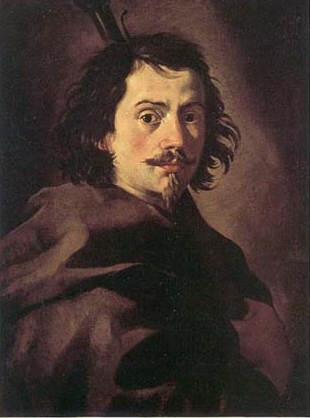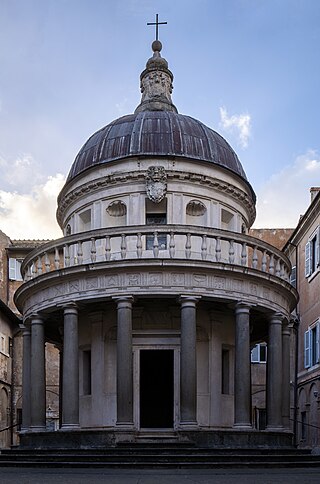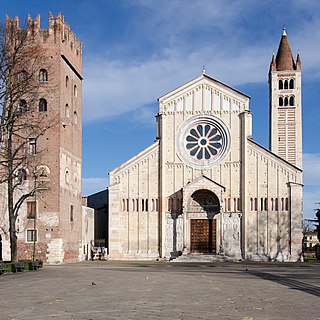
Francesco Borromini, byname of Francesco Castelli, was an Italian architect born in the modern Swiss canton of Ticino who, with his contemporaries Gian Lorenzo Bernini and Pietro da Cortona, was a leading figure in the emergence of Roman Baroque architecture.

Renaissance architecture is the European architecture of the period between the early 15th and early 16th centuries in different regions, demonstrating a conscious revival and development of certain elements of ancient Greek and Roman thought and material culture. Stylistically, Renaissance architecture followed Gothic architecture and was succeeded by Baroque architecture. Developed first in Florence, with Filippo Brunelleschi as one of its innovators, the Renaissance style quickly spread to other Italian cities. The style was carried to other parts of Europe at different dates and with varying degrees of impact.

Vicenza is a city in northeastern Italy. It is in the Veneto region, at the northern base of the Monte Berico, where it straddles the River Bacchiglione. Vicenza is approximately 60 kilometres (37 mi) west of Venice and 200 kilometres (120 mi) east of Milan.

Pediments are a form of gable in classical architecture, usually of a triangular shape. Pediments are placed above the horizontal structure of the cornice, or entablature if supported by columns. In ancient architecture, a wide and low triangular pediment typically formed the top element of the portico of a Greek temple, a style continued in Roman temples. But large pediments were rare on other types of building before Renaissance architecture. For symmetric designs, it provides a center point and is often used to add grandness to entrances.

Dionigi Tettamanzi was an Italian prelate of the Roman Catholic Church, who was named a cardinal in 1998. He was Archbishop of Genoa from 1995 to 2004 and Archbishop of Milan from 2004 to 2011.

Sant'Ambrogio e Carlo al Corso is a basilica church in Rome, Italy, facing onto the central part of the Via del Corso. The apse of the church faces across the street, the Mausoleum of Augustus on Via di Ripetta.

Atessa is an municipality in the province of Chieti, Abruzzo, south-eastern Italy. It is part of the Val di Sangro mountain community. It is the largest municipality in the province by extension and eighth by population.

The Baroque Churches of the Philippines are a collection of four Spanish Colonial-era baroque churches in the Philippines, which were included in UNESCO's World Heritage List in 1993. The churches are also considered as national cultural treasures of the country.

The Basilica of Sant'Ambrogio is an ancient Romanesque-style, Roman Catholic church in the center of Milan, region of Lombardy, Italy.

San Babila is a Romanesque-style Roman Catholic church in Milan, region of Lombardy, Italy. It was once considered the third most important in the city after the Duomo and the Basilica di Sant'Ambrogio. It is dedicated to Saint Babylas of Antioch.

The Basilica di San Zeno is a minor basilica of Verona, northern Italy constructed between 967 and 1398 AD. Its fame rests partly on its Romanesque architecture and partly upon the tradition that its crypt was the place of the marriage of Shakespeare's Romeo and Juliet. It stands adjacent to a Benedictine abbey, both dedicated to St Zeno of Verona.

San Marco is a church in Milan, northern Italy.

The Metropolitan Cathedral of Saint Paul, commonly known as St Paul's Cathedral or the Mdina Cathedral, is a Catholic cathedral in Mdina, Malta, dedicated to St. Paul the Apostle. The cathedral was founded in the 12th century, and according to tradition it stands on the site of where Roman governor Publius met St. Paul following his shipwreck on Malta. The original cathedral was severely damaged in the 1693 Sicily earthquake, so it was dismantled and rebuilt in the Baroque style to a design of the Maltese architect Lorenzo Gafà between 1696 and 1705. The cathedral is regarded as Gafà's masterpiece.

The Saint Augustine Church, commonly known as the Paoay Church, is a Roman Catholic church in the municipality of Paoay, Ilocos Norte in the Philippines. Completed in 1710, the church is famous for its distinct architecture highlighted by the enormous buttresses on the sides and back of the building. It is declared as a National Cultural Treasure by the Philippine government in 1973 and a UNESCO World Heritage Site under the collective group of Baroque Churches of the Philippines in 1993.

Mario Enrico Delpini is an Italian prelate of the Roman Catholic Church. He has been serving as the archbishop of Milan since his installation on 9 September 2017. He previously served as auxiliary bishop and vicar general of that archdiocese.

The Saint Peter Metropolitan Cathedral, also known as the Tuguegarao Cathedral, is an 18th-century Baroque Roman Catholic church located along Rizal Street, Barangay Centro 10, Tuguegarao, Cagayan, Philippines. The church, originally built by Dominican friars, is the seat of the Roman Catholic Archdiocese of Tuguegarao and is considered one of the largest churches in the Cagayan Valley. A historical marker bearing a brief history of the church was installed in 1982 by the National Historical Institute, precursor of the National Historical Commission of the Philippines.

The San Raimundo de Peñafort Parish Church, commonly referred to as the Malaueg Church or Rizal Church, is an early 17th-century Baroque Roman Catholic church located at Brgy. Poblacion, Rizal, Cagayan, Philippines. The parish church, with Saint Raymond of Peñafort as its titular patron, is under the jurisdiction of the Roman Catholic Archdiocese of Tuguegarao. The church structure has been declared a National Cultural Treasure by the National Museum of the Philippines in 2001. A marker, bearing a brief history of the church, was installed on the church's facade by the National Historical Commission of the Philippines.

The San Luis Gonzaga Parish Church, also referred to as San Luis Church, is a 19th-century Baroque Roman Catholic church located at Brgy. Poblacion, San Luis, Pampanga, Philippines. The parish church, dedicated to Saint Aloysius Gonzaga, is under the Archdiocese of San Fernando.
San Domenico is a Gothic-style Roman Catholic co-cathedral located on Largo Maranesi in Fermo, in the region of Marche, Italy.

San Nicolò all'Arena is a Roman Catholic parish church in the historic centre of Verona, Italy dedicated to Saint Nicholas. It is located close to the Arena, a well-preserved 1st century AD Roman amphitheatre. The present Baroque building was constructed between 1627 and 1683 on the site of an earlier Romanesque church which had existed since the 12th century or earlier. The church's façade remained incomplete until the neoclassical façade of the church of San Sebastiano was relocated to San Nicolò in the 1950s, after the former church was destroyed during World War II.



















